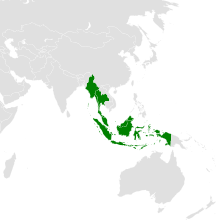Black-thighed falconet
| Black-thighed falconet | |
|---|---|
 |
|
| Scientific classification | |
| Kingdom: | Animalia |
| Phylum: | Chordata |
| Class: | Aves |
| Order: | Falconiformes |
| Family: | Falconidae |
| Genus: | Microhierax |
| Species: | M. fringillarius |
| Binomial name | |
|
Microhierax fringillarius (Drapiez, 1824) |
|
 |
|
The black-thighed falconet (Microhierax fringillarius) is one of the smallest birds of prey, typically measuring between 14–16 centimetres (5.5–6.3 in) long, with a 27–32 centimetres (11–13 in) wingspan, which is a size comparable to a typical sparrow. It is native to Brunei Darussalam, Myanmar, Thailand, Malaysia, Singapore and Indonesia. and vagrant to Sri Lanka.
Thomas Horsfield described to the Linnean Society of London in 1820 a Javan variety of Falco cærulescens (the collared falconet). He noted that "the Javan specimens are somewhat smaller, and differently marked" than the Bengal specimen which had been described by John Edwards in 1750. A fuller description was published in his 1824 book, Zoological Researches in Java.
Also in 1824, Drapiez published the name Falco fringillarius, and Vigors proposed the genus Ierax or Hierax.
This is a minute, shrike-like falcon, with a squarish tail that is frequently spread. The adult male is glossy black above, with a white forehead streak that arcs around black cheeks. It has a white or rufous-washed throat, with a white breast shading into a rufous abdomen. Its thighs and flanks are black, as is its cere and legs. In flight the male has white wings underneath with black barring on the primaries and secondary flight feathers, and light streaking on the underwing coverts. There are three white bars underneath on the otherwise plain black tail. The adult female is similar to the adult male, except the tail is longer. The juvenile is similar to the adults, except that the white areas of the head are rufous. The voice is a hard, high-pitched cry shiew and a fast repeated kli-kli-kli-kli.
The typical habitat is forest, forest edge and wooded open area. It can also frequently be found around human cultivation, villages, and near active slash-and-burn forest clearance; often by rivers, streams, and paddy fields. It mostly lives below 1,500m elevation.
...
Wikipedia

